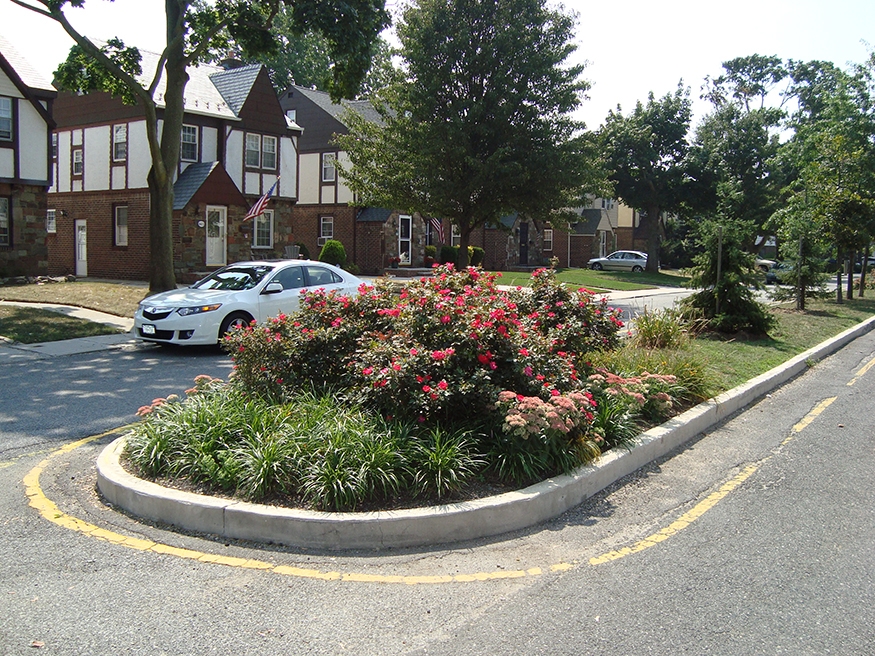Usage: Wide
A raised area separating different lanes, traffic directions, or roadways within a street. The raised median can be either curb height (6–7 inches) or, where appropriate, 12 – 24 inches high. The width as well as design of raised medians can vary widely. They can range from narrow raised concrete islands to tree-lined promenades to intensively landscaped boulevard medians. In contrast to Pedestrian Safety Islands, raised medians extend for most or all of the street block.


Grand Concourse, Bronx

253rd Street, Queens
Benefits
- Reduces risk of left-turn and vehicle head-on collisions
- Calms traffic by narrowing roadway
- Enhances pedestrian safety and accessibility by reducing crossing distances and providing refuge for pedestrians to cross road in stages
- Discourages dangerous mid-block crossing when used with fencing or planting
- If designed for walking access, can provide additional pedestrian activities and amenities such as benches
- Greens and beautifies the streetscape if trees and/or plantings are incorporated. See Raised Median (Curb Height) and Raised Median (12-24 Inches) in the Landscape chapter
- Improves environmental quality and can incorporate stormwater source controls
- Can provide space for a pedestrian walkway and/or Grade-Separated Bike Lane, particularly as part of a boulevard treatment
Considerations
- May impact underground utilities and manholes
- Design must account for impact of raised median on emergency vehicle movement and access
- Design must account for impact of raised median on driveway access where roadway narrowing makes it more difficult for vehicles to maneuver
- Landscaping (excluding street trees) or stormwater source controls require a partner for ongoing maintenance, including executing a maintenance agreement
- If there is a maintenance partner, design of the landscaped area should consider the inclusion of an irrigation system to reduce the cost of long-term maintenance and enhance overall plant health
- Changes in traffic circulation resulting from addition of raised median should be understood so as to not force drivers to travel on inappropriate routes or make U-turns
Application
- Consider on all two-way multilane streets
- On streets of limited width, it may be preferable in some situations to include other treatments (e.g., expanded sidewalks or dedicated transit or bike facilities) rather than a raised median if there is not adequate room for all treatments and travel lanes
Design
- Raised medians should be a minimum of 7 feet wide to provide detectable warnings and refuge to pedestrians at crossings
- Raised medians should extend beyond the crosswalk at intersections wherever possible, while accommodating vehicle turning movements; the “nose” of the raised median should include bollards to protect pedestrians from wayward vehicles
- Turning radii must be sufficient for the design vehicle and may constrain the length or width of the median "nose." This adjustment may shift the pedestrian cut through away from the desire line
- Provide a walkable path across the raised median at crossings. When the median (with a standard 7-inch curb) is less than 17 feet wide, an 8 – 10-foot-wide cut-through, flush with the roadway, is appropriate. On medians wider than 17 feet, pedestrian ramps (1:12 grade with 5-foot landing areas) can be used to provide access.
- Provide a large area at crossings to permit groups of pedestrians to safely wait
- Provide tactile cues for pedestrians with vision disabilities to indicate the border between the pedestrian refuge area and the motorized travel lanes
- Include street trees, plantings, and unpaved or permeable surfaces wherever safe and feasible, using structural soil where appropriate. See Tree Beds, Raised Median (Curb Height), and Raised Median (12-24 Inches) in the Landscape chapter, and Precast Porous Concrete Panel in the Materials chapter
- Where feasible and if there is a maintenance partner, design planted areas within raised median so as to capture stormwater according to current standards. See Stormwater Management Practices in the Landscape chapter
- If work includes tree planting, consider the location of utility infrastructure, including DEP sewers and water mains; also consider visibility for motorists, cyclists, and pedestrians
- Grade roadways to direct stormwater towards raised medians if the raised medians include stormwater source controls, for example through the use of double or inverted roadway crown
- Raised medians must be designed so as to maintain drainage of stormwater and not cause ponding


